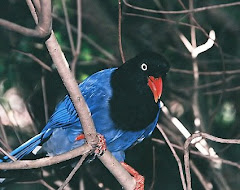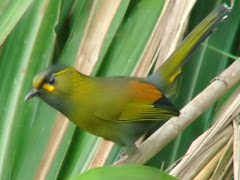
Yes, it's official! The Eastern Taiwan Strait population of humpback dolphin has been officially classified as Critically Endangered (CR) on the Cetacean update of the 2008 IUCN Red List of Threatened Species. Now, you're asking why are we going on about dolphins on a birding blog? Well, keep reading and you'll see this does concern birds, too.
The International Union for Conservation of Nature (IUCN) has recognised the overwhelming threat to these animals and have classified them as Critically Endangered, the highest category of threat-level on the Red List for wild animals before becoming extinct.
What this means is that unless drastic steps are taken to protect this species, they will be driven to extinction !
The reduced flow of freshwater into the humpback dolphins estuarine habitat resulting from the Hushan Dam Project is seen as a major threat to these unique dolphins. The Dacheng (Tacheng) Important Bird Area (IBA), an important wintering site for the vulnerable Saunders's Gull Larus saundersi, falls within this area at the mouth of the Jhoushui River and will also be very negatively impacted by the reduced flow of freshwater.
The Hushan Dam Project is destroying large areas of forest habitat upriver within and around the Huben-Hushan Important Bird Area (IBA). The Huben-Hushan IBA was designated as an IBA by BirdLife International as the area is globally the most important breeding area for the threatened Fairy Pitta Pitta nympha. The IBA is home to several other Red List bird species (See Threatened Birds of The Huben-Hushan IBA Area for more information). The dolphins act as an important umbrella species, and we hope that the new Critically Endangered status of the dolphins will help to protect their habitat which is shared by the birds and many other creatures.
The IUCN refers to the Taiwan humpback dolphins as the Eastern Taiwan Strait humpback dolphin Sousa chinensis and classifies them as a sub-population.
There can be no doubt now over the threat these dolphins face and the need for something drastic to be done to save these unique animals and pull them back from the brink of extinction. The time has come for the Taiwan government to stop dodging the issue of meaningfully protecting these dolphins and to do something concrete to save them. The writing is on the wall now and any failure of the authorities to act will be nothing short of signing the death warrant of this unique population of Taiwanese dolphin.
Our appreciation to the Cetacean Specialist Group of the IUCN Species Survival Commission for their work in this and our thanks to all at the MFCU and our supporters who have helped bring this about both here in Taiwan and abroad. We eagerly await the government's response to this and trust that they will make a genuine meaningful effort in saving these unique and rare citizens of Taiwan.
Also see:
Summer Dolphin Observation & Surveys - volunteers needed
Press Release: Taiwan’s unique population of Indo-Pacific humpback dolphins is on the brink of extinction
Matsu’s Fish seizes “Critically Endangered” title, winning international glory for Taiwan
Dolphins Critically Endangered - Media coverage
Save the Taiwan Humpback Dolphins Blog
Stop Hushan Dam Blog











































